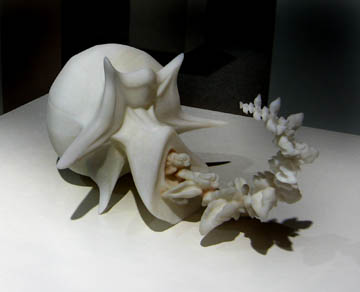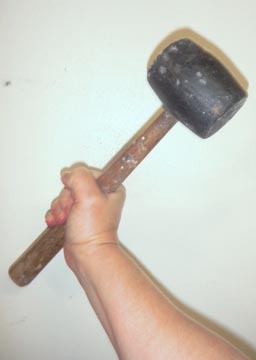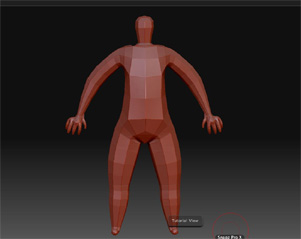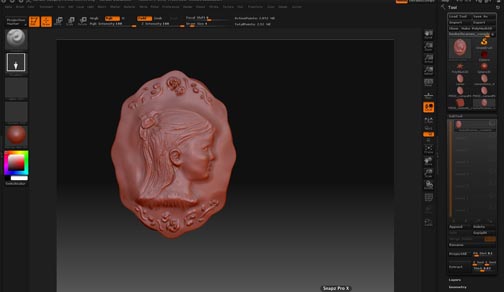Technology
New Art and Technology Podcasts Are Coming. Here Is A Bit About Our First Guest.

The Art and Technology is my second podcast.
To date I have recorded and edited 68 podcasts.
We have been working hard all weekend to set up a new community at digitalsculpting.net. It will be a portal of information, tutorials, galleries etc on digital sculpting and the technology surrounding it. I encourage everyone to join. It is huge and will continue to grow, with people and information. You can create your own profile, blog, gallery etc.
As part of this information community we are starting a new podcast titled,
Art and Technology
“A fire side chat where innovation, creativity, technology and science meet.”
We are just waiting for our introduction by Jazz Legend Harry Sheppard, and then our podcasts will be up. I expect that to be next week sometime. In the mean time, here is a little about our first guest, Robert Michael Smith.
Robert Michael Smith
- A pioneer in digital technology and sculpting
- A traditional sculptor. * Was founding web director of the International Sculpture Center
- Sat on the board of Directors of the International Sculpture Center*
- 1993-2003 Bord member for the Manhattan chapter of SIGGRAPH
- President Emeritus of the Sculptors Guild, founding board member of the Digital Stone Project
- Professor NYIT Fine arts
- Featured in the Digital Stone Exhibition Sponsored by Autodesk
A complete bio follows:
Robert Michael Smith is a digital sculptor and Associate Professor of art and technology at New York Institute of Technology Fine Arts Department. Smith is also NYIT Middle East Fine Arts Computer Graphics Coordinator for Global Exchange Programs at Amman, Jordan; Kingdom of Bahrain, and Abu Dhabi, United Arab Emirates. Recently Smith has established a collaborative digital art gallery at Beijing, China.
Smith has been an active pioneer of digital sculpture, 3D visualization/animation, Web design, virtual sculptures for the Web, virtual actors for computer gaming, as well as a significant art and technology educator. During 1999-2003 Smith was a Board Director for Manhattan chapter of SIGGRAPH. Smith was the Web Director of www.sculpture.org during 1997-2003 and a Board Director of the International Sculpture Center during 2003 -2005. Smith is President Emeritus of the Sculptors Guild, and a founding Board Director of Digital Stone Project.
Smith previously taught throughout New York City at Pratt Institute, School of Visual Arts, The New School for Social Research, Parsons School of Art & Design, The Sculpture Center, as well as University of the Arts at Philadelphia, University of North Dakota, University of Hawaii at Manoa, and San Jose State University. Smith has also been a guest lecturer at numerous universities, international conference
s, and featured in several international articles and books including two chapters, “Digital Imaging” and “Digital Sculpture” in the recent Thames & Hudson publication “Art of the Digital Age”, by Bruce Wands.
Smith’s sculptures and digital art have been exhibited at prestigious New York City, NY venues including:
Sculpture Center; P.S. 1 Contemporary Art Center; Asian American Arts Center; Blum Helman Warehouse; and
The Corning Gallery at Steuben; The Rubelle & Norman Schafler Gallery, Pratt Institute, Brooklyn, NY; as well as National venues including: Pittsburgh Center for the Arts, Pittsburgh, PA; Chesterwood, Stockbridge, MA; Grounds for Sculpture, Hamilton, NJ; Rockland Center for the Arts, Nyack, NY; FermiLab, Batavia, IL; Exploratorium, San Francisco, CA; Downey Museum of Art, Downey, CA; Tucson Museum of Art, Tucson, AZ; Honolulu Academy of Arts, Honolulu, HI; Sculpture Tour, University of Tennessee / Knoxville; Nave Museum, Victoria, TX; Leigh Yawkey Woodson Art Museum, Wausau, WI; North Dakota Museum of Art, Grand Forks, ND; Muskegon Museum, Muskegon, MI; Tyler Museum of Art, Tyler, TX; Edwin A. Ulrich Museum of Art, Wichita, KS; University of Alabama Art Gallery, Birmingham, AL; The Alexandria Museum, Alexandria, LA ;The Plain’s Art Museum, Moorhead, MN; The Rourke Art Gallery, Moorhead, MN; Hillwood Art Museum, Brookville, NY; Southwestern University, Georgetown, TX; Robert Fullerton Art Museum,
San Bernadino, CA; The Alexandria Museum.

A sculpture created in Mudbox and
digitally printed in ABS plastic with the
Stratasys Dimension RP machine.
Alexandria, LA; University of Oklahoma Museum of Art, Norman, OK; Alaska State Museum, Juneau, AK; University of Alaska Museum, Fairbanks, AK; Anchorage Historical and Fine Arts Museum, Anchorage, AK; Fine Art Museum of the South, Mobile, AL; Gaston County Museum,
Dallas, NC; West Bend Gallery of Fine Arts, West Bend, WI
International exhibition venues have included: Art Cologne, Germany; Supermarket 2008, Stockholm, Sweden; Foresight Art Center, Amman, Jordan; Museum of Science and Industry, Manchester, England; Museo de Monterrey, Monterrey, Mexico;
UTS Gallery, Sydney, Austr
alia; Yeditepe University, Istanbul, Turkey; Snowhite Gallery, Aukland, New Zealand;
Taiwan Museum of Art, Taichung, Taiwan; Kaohsiung Museum of Fine Arts, Kaohsiung, Taiwan; Queen’s Square, Newcastle upon Tyne, England; Galleria Arte Mod
erna, Forte di Marmi, Italy; Gallerie Graphe, Paris, France;
Conseil Général de Meurthe-et-Moselle, Nancy, France; Isla Center for the Arts, Mangilao, Guam.
During 2008 – 2009 Robert Michael Smith was a featured artist along with Bruce Beasley, Jon Isherwood and Kenneth Snelson in “Digital
Stone”, an exhibition sponsored by Autodesk that toured at contemporary art museums throughout China, including Beijing Today Art Museum, Shanghai Duolun Museum of Modern Art, Jinse Gallery at Chongqing, and Art Map Gallery, Wenzhou. A sculpture by each artist was purchased for the permanent collection of China National Museum of Fine Arts at Beijing.
An Update On The New Art And Technology Podcasts
Many are waiting patiently for the new Art and Technology podcasts.
“A fire side chat where innovation, creativity, technology and science meet. “
We have completed our first four interviews. I think you will find the topics very interesting. I have a couple more scheduled for this week, however, we are awaiting our introduction from Jazz Legend Harry Sheppard and for the new website digitalsculpting.net to be complete. The new Digital Sculpting.net website is a community site that we hope to offer many resources on. It is still in the “construction” phase. All of the podcasts will be housed there and you will also find accompanying articles and posts on the podcast here. Podcasts will also be available in iTunes. More information to come.
A Comparison Between Traditional And Digital Armatures— or Banging ZSpheres Into Submission
by Bridgette Mongeon ( this is a free article. You may copy it for your website. Follow information below.)

armatures into submission. Not so
with digital. HOLD ME BACK!
As a traditional sculptor who has spent 30 years of creating physical objects I am moving into digital technology and instead of just creating in my dusty studio, I am also creating within the box, the computer, that is on my desk, in my office. Presently I am working on the mesh or ZSpheres of a model in Pixologic’s ZBrush. I’m moving on to the 6th revision of this model. It is as tedious, if not more so, as the creating of a traditional life-size or monumental armature, but it is also just as necessary.
Picture this; you are in the throws of creating traditionally. The art is materializing before your eyes and you have all of the excitement that goes along with it, but without a proper armature for you clay to sit on; the traditional sculptor knows that you can walk into your studio one morning and find that your masterpiece has crumbled to the ground, sagged or broken into pieces.
Here I sit. My tools are different. It is not a welding rod, spray foam, chicken wire and mallet. It is a Cintiq tablet and a stylus pen. I have pushed and pulled ZSpheres and struggled with the ZSphere model for a week. (Pixologic tutorials state that creating this digital armature would be much easier if I had ZBrush 3.5. Zbrush 3.5 is only offered to those working on the PC and not available to Mac users at this time. ) If I had it, then I would have access to ZSketch, a tool that the Pixologic web site states is, “A new technology based on the ZSphere which will let you freely create your models without restrictions.” This is supposed to be much more intuitive and more like traditional sculpting. It is supposed to make creating the digital armature model, or mesh easier. I would even resort to moving to a PC to create in the ZSketch if I had a copy of ZBrush 3.5 for the PC, and it was true about the miraculous ability of this ZSketch. Then I could bring the sculpture back into my Mac using ZBrush for sculpting.
The process of “easily” creating a model to sculpt on, from scratch, in either Pixologics ZBrush or Autodesk’s Mudbox, in this sculptor’s opinion, is the missing link in these “intuitive” sculpting programs. This is a huge hindrance for those traditional sculptors who might like to utilize these tools in their own workflow. Without an easy way of digital modeling your armature through pushing and pulling on the screen, it is necessary to incorporate other means of 3D modeling. That would mean learning a modeling program, such as 3D’s max, Maya, Cinema 4D, Lightwave, Carrara or blender. For me, these programs feel even less intuitive to the traditional sculpting process. Modeling in a software program does not compare to the traditional process of sculpting. Hiring someone to create a digital model for my artwork feels similar to the process of hiring someone to create a traditional armature and roughing in the design. To me, hiring someone makes the process feel less organic; I feel divorced from an integral part of the creative process.
Here I sit. My tools are different. It is not a welding rod, spray foam, chicken wire and mallet. It is a Cintiq tablet and a stylus pen. I have pushed and pulled ZSpheres and struggled with the ZSphere model for a week. (Pixologic tutorials state that creating this digital armature would be much easier if I had ZBrush 3.5. Zbrush 3.5 is only offered to those working on the PC and not available to Mac users at this time. If I had it, then I would have access to ZSketch, a tool that the Pixologic web site states is, “A new technology based on the ZSphere which will let you freely create your models without restrictions.” This is supposed to be much more intuitive and more like traditional sculpting. It is supposed to make creating the digital armature model, or mesh easier. I would even resort to moving to a PC to create in the ZSketch if I had a copy of ZBrush 3.5 for the PC, and it was true about the miraculous ability of this ZSketch. Then I could bring the sculpture back into my Mac using ZBrush for sculpting.
Though creating armatures both traditionally and digitally is tedious work, it is this primal time of the creation that the “feel” of a sculpture presents itself and entices the artist to the creative dance. Another option to modeling is to rough in a small sketch, in traditional clay. A simple roughed in clay that shows form and gesture. Then, scan this sculpture with a 3Dscanner. We are using the Next Engine Scanner in the process. This process is what I call tra-digi art. I discuss it process in the New Mudbox book “Digital Sculpting with Mudbox: Essential Tools and Techniques for Artists” By Bridgette Mongeon and Michael de la Flor. It is necessary to note that scanning is still not a smooth transition. It will be necessary to retopologize this scan to be able to work on it in either ZBrush or Mudbox. The reason is that scanned models are in triangles, and it is necessary to have a model made with quads, or you will, once again, have artifacts and problems down the road. For a better description of why this is important check out this wonderful video on Subdivision Topology: Artifacts at Guerilla CG.
Learning how to retopologize is not as difficult as learning modeling in another program, but it is still work, and not as “true to the process of traditional sculpting.”
So, back to ZSpheres. The frustration of working with ZSpheres without ZSketch can be compared to the experiences I have downstairs in the traditional studio space. The only difference is when a traditional sculpture will not bow to my will; I will take a hammer from my closet of tools and bang the armature into submission. This technique is also an excellent relief of some of my own creative frustration. Working in ZBrush with ZSpheres allows me to push and pull without the physical effort or the clay under my nails. But my digital armature is far from being complete or correct and I am beginning to feel the need for a hammer.
With 30 years of experience in a traditional studio, I intuitively know what will or will not work in armature building. In the traditional studio, the type of armature I make and the type of clay used will depend on what final results I am after. Is this wet clay or is it wax-based clay? Will I be cutting this sculpture off the armature and then hollowing it out for firing or will I be sawing the armature apart with a reciprocating saw, dividing it up into many pieces to go to a foundry for mold making and bonze casting? These are questions I ask myself before beginning a traditional armature. The answers give me direction to create the appropriate support.
I do not have this same experience or intuition of digital armature building. I have no doubt that in the very near future, I will be working along on my digital creation, long after the building of the model or mesh and then I will find I cannot get the tool to work properly. An artifact or a bump in the sculpture’s topology—the underlying armature, will most likely be the cause. I will not be able to smooth and I will not be able to sculpt. I will wish I spent more time on creating a proper ZSphere model.
As with traditional sculpture, I must know what my final output will be. If this sculpture creation, that sits within the computer, is to be used in animation, then this armature or model needs to be created in such a way that the final piece can be animated. Bad topology or a bad mesh can cause problems in texturing and even the final rendering. In other words, I will not be able to generate an image of my creation.
My plans are to continue on with this digital model and invite a seasoned pro to my office to look at my digital armature, and perhaps give me some solutions and tricks in working with ZSpheres. Meanwhile, I check with the Pixologic website daily, to see if they are announcing the Mac version of ZSketch, so that I may prove for myself that it certainly does work more like traditional sculpting. And oh yes, I’ll keep the hammer downstairs in the traditional studio, just incase I get the urge to bang my mesh into submission and in doing so destroy my very costly equipment.
*
Bridgette Mongeon is a sculptor and writer and co-author of the new book
“Digital Sculpting with Mudbox: Essential Tools and Techniques for Artists”
She is also the host of a new podcast called Art and Technology
“A fire side chat where innovation, creativity, technology and science meet. ” For more information visit the artists blog
*
This is a free article you are welcome to use it on your website or blog. It must incorporate the writer/artist credit above.
Please also download all of the photographs to your own server.
Having A Wonderful Time With This!
I’m having a wonderful time with the new Art and Technology podcasts. We recorded our third one this morning. It is about 3D and copyright. A huge topic, and one that I think we will talk about quite often on this podcast. Here is a link to the case that we discussed along with our own experiences and thoughts about digital technology and copyright issues. Last week I had Materialise on the podcast and they shared their process and some of the incredible new things that will be around for artists working in 3D that want to get their artwork out of the computer.
Next week I have another exciting conversation. These are really fire side chats. Informal conversations on different aspects of digital sculpting, and traditional sculpting. The entrance line to the podcast is…
” Welcome to the art and technology podcast at digtialsculpting.net.
A fireside chat where innovation, creativity, technology and science meet.”
Now I just need to get the website up. I’m working diligently at this. It will be a community of artists talking about different subjects.
New Artwork- Working On A Cameo
Creating a bas-relief, a portrait that is flat and appears to have dimension, is something that I am asked to do quite often but have not had the chance to create. In the past, with the busy commission schedule in the studio I rarely have time to play in something or experiment. It is something that I have enjoyed about my graduate studies, exploration with play, and I love documenting my work! Working with a bas-relief created digitally was a way to explore this new style of sculpting.
The inspiration behind this new direction is the many cameos that my mother has given to me over the years. Beautiful women are sculpted in a variety of materials. Of course sculpting that small, the size of a brooch is a bit tedious and hard on the eyes. Besides I didn’t just want to make any person, I wanted to do a specific person.I was wondering if I could create this type of art using tra-digi means( traditional and digital process). Here are some photographs of my first attempts. I’m going to try some others and then have them printed or milled out as jewelry.
I love The Guerrilla CG Project- Get Involved! Quality!
I absolutely love The Guerrilla CG Project. I think these tutorial videos are excellent. If you are into Computer Graphics and want to be a part of an incredible educational experience let me introduce you to The Guerrilla CG Project. Go to their website and check it out.
Zbrush and Zsketch- Is It As Good As It Looks?
Now the Mudbox book is complete I can dive into Zbrush and see what it can do for me. I’m excited about combining these two programs to see what I can “carve” out for myself. ZBrush 3.5 has a new process called zsketch. I’m interested to find out if this really works as good as it seems to. Unfortunately they do not have this for the mac version yet. I may end up in another office trying it out on a PC
As a traditional sculptor trying to introduce other traditional sculptors how to enter this field without having to learn 3d modeling in a modeling program it has been almost impossible. I did figure out a way using Mudbox which I write about in the book, but if this zsketch really works and makes good models. Well then that will be wonderful.
I found this great thread showing some of the zsketch capabilities and the work of a poster called painzang. The video is also his. What he is doing is creating the zspher model under a zsketch. ( updated 2020 this post is over 10 years old. Zbrush has come a long way since these simple zsketches)
Calling artist and those interested in technology and art.
I love the ideas behind Adrian Bowyer and the Rep Rap. Here are two new videos.
A short one discussing the entire concept behind rep rap.
TAKE NOTE: a rep rap new addition. extruder for ceramic. Oh I must get something in my own studio.
PLEASE NOTE:
I am wanting to write articles and podcast interview about several topics concerning 3d printing and art and technology. Please contact me at bridgette@creativesculpture.com if you have suggestions.
The podcasts, articles and other information will be collected and distributed from a new website that will be going live no later than May 2010. It will be located at digitalsculpture.net.
I have also pitched another book to my publisher about art and technology ( 3d physical artwork such as sculpture etc). I am looking for artists to include in this book as well as those doing research and service bureaus.
More Great Information About 3D Printing And Our Podcast
Can I be any more excited about my new endeavors? We just completed our second podcast with Joris Debo from Materialise. Oh the very interesting things I found out about the services that are going to be made available for digital printing. It was a great conversation and Joris will be sending more information concerning 3d printing that we can include on our new website. The website digitalsculpting.net will be up no later than May. We are working out all of the details of the site. All of these podcasts will be put up there.
Time to secure podcast interview #3.
More News In Digital 3D Printing Of Ceramics
I love to pass on interesting information as it pertains to technology and art especially when it has to do with sculpture.
Here are some wonderful links.
Ceramics Research from the Emily Carr University in British Columbia
And of course a regular ongoing plethora of information Solheim’s blog







